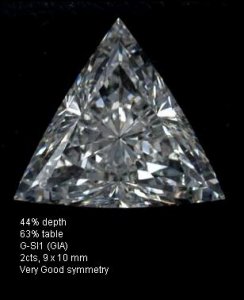You are using an out of date browser. It may not display this or other websites correctly.
You should upgrade or use an alternative browser.
You should upgrade or use an alternative browser.
Trillion cut diamonds
- Thread starter baguettel
- Start date
- Status
- Not open for further replies. Please create a new topic or request for this thread to be opened.
- Joined
- Aug 29, 2003
- Messages
- 15,808
Lower quality???? No way!
The shape is more readily found in small stones used as sides - this is one reason why singles in "side-stone" sizes are to be found at a discount. However, you will find quite a few solitaires with trillion centers. The shape is reputed for giving allot of spread for the weight and it is cut below 60% depth - most often. I do not have a large one, but the largest I saw in a solitaire was about 5 cts and quite spectacular. Teh shape is not reputed to be very brilliant (= as in light return) but rather achieves the look of older cuts (flashes of light and great contrast brilliance, which you may find defined in one of Jonathan (aca "Rhino") posts around here).
Here are two examples of what i was talking about: at Jewelry Expert and Diamonds by Lauren (scroll down)
Hope this helps...
The shape is more readily found in small stones used as sides - this is one reason why singles in "side-stone" sizes are to be found at a discount. However, you will find quite a few solitaires with trillion centers. The shape is reputed for giving allot of spread for the weight and it is cut below 60% depth - most often. I do not have a large one, but the largest I saw in a solitaire was about 5 cts and quite spectacular. Teh shape is not reputed to be very brilliant (= as in light return) but rather achieves the look of older cuts (flashes of light and great contrast brilliance, which you may find defined in one of Jonathan (aca "Rhino") posts around here).
Here are two examples of what i was talking about: at Jewelry Expert and Diamonds by Lauren (scroll down)
Hope this helps...
- Joined
- Aug 29, 2003
- Messages
- 15,808
- Joined
- May 3, 2001
- Messages
- 7,516
I rarely see trillions as deep as you prefer. They are mostly cut from flats or macles which do not lend themselves to deeper stones such as the round. Perhaps one of our more research oriented gemologists will have a picture of a macle to share with us and you will see why the trillions are cut the way that they are. The trillion was actually a great boon to diamond cutters as it gave them a way to effectively use this type of rough.
Because they are cut from a less desireable shape of rough, they will be much less expensive than a round of the same weight.
Wink
Because they are cut from a less desireable shape of rough, they will be much less expensive than a round of the same weight.
Wink
kkeen15
Shiny_Rock
- Joined
- Apr 3, 2004
- Messages
- 117
- Joined
- Aug 29, 2003
- Messages
- 15,808
Macle? sure... here are some better than average close-ups LINK and a different use of (un-cuttable) diamond roungh

And one pic under the Iscope (LINK). I would expect a trilliant to look as "sparkly" as a good OMC or a good oval (present on that page too). 'Bow tie' here would be the sector just in the middle of the sides - so a three-sides bow-tie
 However, I find it less obvious than in any other shape - maybe because the shallower depth of the trillions do not allow these areas to become "reflectors" (black under Iscope) like they might in ovals or radiants. Actually, I thought "bow-tie" is more theory than visual impression for this shape, but the IScope images seem to show "something" in that area... for better or worse.
However, I find it less obvious than in any other shape - maybe because the shallower depth of the trillions do not allow these areas to become "reflectors" (black under Iscope) like they might in ovals or radiants. Actually, I thought "bow-tie" is more theory than visual impression for this shape, but the IScope images seem to show "something" in that area... for better or worse.

And one pic under the Iscope (LINK). I would expect a trilliant to look as "sparkly" as a good OMC or a good oval (present on that page too). 'Bow tie' here would be the sector just in the middle of the sides - so a three-sides bow-tie

- Joined
- May 3, 2001
- Messages
- 7,516
- Status
- Not open for further replies. Please create a new topic or request for this thread to be opened.
Share:
Past, Present, Future: The Meaning of Three-Stone Engagement Rings
Past, Present, Future: The Meaning of Three-Stone Engagement Rings - 04/14




300x240.png)